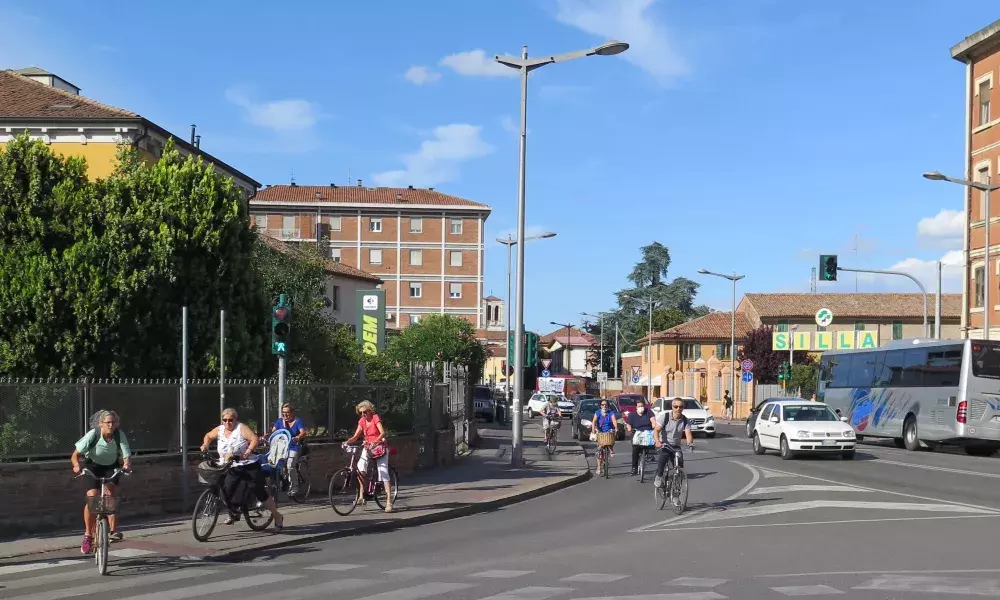Analysing Commuting Patterns in Ferrara towards Better-Informed Policy Decisions

The analysis – carried out by Project Partner S.I.PRO. Ferrara Development Agency – sets to answer to specific questions related to commuting practices, among which:
- What are the most frequent routes?
- What are the main destinations of commuters coming from outside the municipality?
- What are the main destinations of commuters coming from outside the province?
- How do commuting behaviours change during the week and over the weekend?
- How do commuting behaviours change at different time slots throughout the day?
- What is the typical demographic profile of train commuters?
To best answer to these questions, the team working on the study, in accordance with municipalities’ technicians, first divided the city in 17 areas, separating, for example, predominantly residential areas from industrial or offices areas.

The study observes the incoming and outgoing daily movements, as well as the internal fluxes of city-users from one area to another. To better understand the dynamics of these movements, the city-users have been categorized in four groups, that can be also filtered by age and gender:

The analysis has been carried out comparing data from four different weeks in four months in 2021, with the same four weeks in 2019 or 2020,1 depending on the availability of data (for regulatory issues the communication company cannot provide data collected more than a certain number of months before), specifically:
- End July early August (2021 compared with the same week in 2019).
- September, start of the schools.
- October, during attractive events occurring in town.
- November, business as usual, without extra or peculiar activities or peaks of flows.
In this way it was possible to have a comparison with a pre-covid (2019) and a post-lockdown restart picture (2021).
Moreover, data has also been clustered by time slots, thus allowing to focus the analysis on the most relevant travel peaks:
- From 6 to 10 a.m. – moment of access to work or to educational facilities.
- From 5 p.m. – moment in which the majority of employees leaves the working space.
- From 6 to 9 p.m. – time slot in which usually the population moves towards evening entertainment events.
Therefore, the analysis of commuting practices keeps into consideration basically three components: ORIGIN – DESTINATION – TIME OF PERMANENCE
In some cases, it was also possible to distinguish between train journeys and journeys made using other means of transportation. This was possible because the platform registered the railway pathways and therefore is able to detect the transition between different stations.
On the basis of these elements, and of the categories of city-users identified, it was possible to provide precise answers to the above-mentioned questions.
1. The partner in charge of the activity, that is S.I.PRO. Ferrara Development Agency, had to postpone the start of the study by a year compared to the original timetable due to the Covid-19 pandemic that had a relevant impact on the commuting patterns. Nevertheless, this allowed for the comparison between a pre-pandemic and a post-pandemic situation.
The categories of city-users have been defined in such a way as to include as many shades of city-users as possible. For example, the limits of permanence in the territory in the definition of commuter workers has been established keeping into consideration the new potential remote-working condition. As per the visitors/ travellers’ category, the group is further split up in two sub-categories: short-term visitors (staying in the area maximum 15 minutes) or long-term visitors (registered in the area for at least 1 hours). This subdivision allows us, among other things, to understand how many people who are travelling by train use the city as an exchange point for other destinations
Tracking individuals’ movements using Big Data and analysis of telecommunications data based on user geolocation and behaviours is an extremely sensitive matter, which requires a robust data protection system in order to safeguard citizens' privacy. In this study, the “privacy issue” is tackled at the source by the data provider, which collects and releases fully anonymised data. The Vodafone Analytics platform, indeed, is only allowed to track journeys for groups larger than 15 users, which is considered the minimum threshold to prevent tracing back from the data to the user.
The data collected allowed the elaboration of considerations on the following topics:
TOURISM
What emerged from the study is that foreign tourist flows have registered a slight increase in the post-Pandemic period, with the preferred mean of transportation being other than rail transport.


For what concerns tourists coming from Italy, especially from the nearby regions, the situation is rather unchanged.

WORKERS’ COMMUTING PATTERNS
Workers’ commuting patterns have been significantly altered, most likely due to the new remote-working practices that emerged during the pandemic and the more individualistic approach to transportation triggered by the fear of being infected. The distribution of the origins of the workers on the territory has not undergone any drastic changes, but the frequency of use of specific travel routes decreased, along with the use of trains.




Overall, the study allowed to identify the location and causes of traffic peaks throughout the day/week; to highlight workers’ top commuting axis and destinations in town; as well as the main origins of commuting flows and means of transportation.

With this information the project may assess the efficiency of road axis and the suitability of the public transportation offer in comparison with the actual demand and need of citizens and city-users, and ultimately orient the city’s policy decisions and objectives.
About this resource
The Urban Innovative Actions (UIA) is a European Union initiative that provided funding to urban areas across Europe to test new and unproven solutions to urban challenges. The initiative had a total ERDF budget of €372 million for 2014-2020.
Similar content




